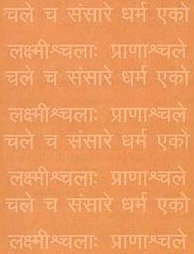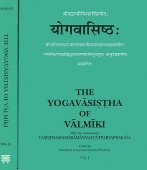Jagrat, Jāgrat: 9 definitions
Introduction:
Jagrat means something in Hinduism, Sanskrit. If you want to know the exact meaning, history, etymology or English translation of this term then check out the descriptions on this page. Add your comment or reference to a book if you want to contribute to this summary article.
In Hinduism
Purana and Itihasa (epic history)
Source: archive.org: Puranic EncyclopediaJāgrat (जाग्रत्).—According to the vision of Ṛṣis or sages, every living being has four states. They are Jāgrat (waking state), Svapna (dream), Suṣupti (profound sleep) and Turīya (the fourth state of the soul, i.e. oneness with Brahman in different degrees). The hermits and sages have said about the four states of soul as given below:— (See full article at Story of Jāgrat from the Puranic encyclopaedia by Vettam Mani)

The Purana (पुराण, purāṇas) refers to Sanskrit literature preserving ancient India’s vast cultural history, including historical legends, religious ceremonies, various arts and sciences. The eighteen mahapuranas total over 400,000 shlokas (metrical couplets) and date to at least several centuries BCE.
Shaivism (Shaiva philosophy)
Source: SOAS University of London: Protective Rites in the Netra TantraJāgrat (जाग्रत्) refers to “being awake”, according to the Netratantra of Kṣemarāja: a Śaiva text from the 9th century in which Śiva (Bhairava) teaches Pārvatī topics such as metaphysics, cosmology, and soteriology.—Accordingly, [verse 15.18-19ab, while describing protection rituals]—“The Mantrin should chant the mantra for the benefit of the consecrated person [the king], in all directions day and night, whether [the consecrated person is] awake (jāgrat) or asleep. The [consecrated] man then stays on Earth, evil spirits cannot kill him”.

Shaiva (शैव, śaiva) or Shaivism (śaivism) represents a tradition of Hinduism worshiping Shiva as the supreme being. Closely related to Shaktism, Shaiva literature includes a range of scriptures, including Tantras, while the root of this tradition may be traced back to the ancient Vedas.
Vedanta (school of philosophy)
Source: ORA: Amanaska (king of all yogas): (Advaita Vedanta)Jāgrat (जाग्रत्) refers to the “waking mind”, according to the Māṇḍūkyopaniṣatkārikā 3.29.—Accordingly, while discussing the dream and waking states: “Just as in the case of dreaming, the mind, which is a reflection of duality, is active because of Māyā, so the waking mind (jāgrat), which is [also] a reflection of duality, is active because of Māyā”.

Vedanta (वेदान्त, vedānta) refers to a school of orthodox Hindu philosophy (astika), drawing its subject-matter from the Upanishads. There are a number of sub-schools of Vedanta, however all of them expound on the basic teaching of the ultimate reality (brahman) and liberation (moksha) of the individual soul (atman).
Yoga (school of philosophy)
Source: ORA: Amanaska (king of all yogas): A Critical Edition and Annotated Translation by Jason BirchJāgrat (जाग्रत्) refers to “(the state of) waking”, according to the Amanaska Yoga treatise dealing with meditation, absorption, yogic powers and liberation.—Accordingly, as Īśvara says to Vāmadeva: “[...] [The Yogin] who always remains as though asleep in the state of waking (jāgrad-avasthā) and is free from breathing in and out, is certainly liberated. People who belong to the mundane world experience sleep and wakefulness, [whereas] the Yogins who have realized the highest reality do not wake and do not sleep. [...]”.

Yoga is originally considered a branch of Hindu philosophy (astika), but both ancient and modern Yoga combine the physical, mental and spiritual. Yoga teaches various physical techniques also known as āsanas (postures), used for various purposes (eg., meditation, contemplation, relaxation).
Languages of India and abroad
Sanskrit dictionary
Source: DDSA: The practical Sanskrit-English dictionaryJāgrat (जाग्रत्).—a.
1) Watching, being awake.
2) Attentive, careful, watchful.
3) Clear, bright. -m. Ved. Dreaming in a waking state, day-dream.
Source: Cologne Digital Sanskrit Dictionaries: Shabda-Sagara Sanskrit-English DictionaryJāgrat (जाग्रत्).—mfn. (-gran-gratī-grat) Watching, being awake. E. jāgṛ to wake, Unadi affix śatṛ.
Source: Cologne Digital Sanskrit Dictionaries: Cappeller Sanskrit-English DictionaryJāgrat (जाग्रत्).—[adjective] waking; [substantive] the state of waking.
Source: Cologne Digital Sanskrit Dictionaries: Monier-Williams Sanskrit-English Dictionary1) Jāgrat (जाग्रत्):—[from jāgṛ] mfn. [present participle] √jāgṛ q.v.
2) [v.s. ...] m. waking, [Vedāntasāra 105; 108; 132; 305.]
[Sanskrit to German]
Sanskrit, also spelled संस्कृतम् (saṃskṛtam), is an ancient language of India commonly seen as the grandmother of the Indo-European language family (even English!). Closely allied with Prakrit and Pali, Sanskrit is more exhaustive in both grammar and terms and has the most extensive collection of literature in the world, greatly surpassing its sister-languages Greek and Latin.
See also (Relevant definitions)
Starts with: Jagradavastha, Jagrata, Jagratagolisu, Jagratavidu, Jagrate, Jagrategollu, Jagrati, Jagratprapanca, Jagratsvapna, Jagratu.
Ends with: Ajagrat.
Full-text: Jagratprapanca, Jakkiratavastai, Sushupti, Cakkiratai, Turiya, Jagratsvapna, Waking mind, Jagradduhshvapnya, Brahma, Jagri, Gatagata, Ananda, Vishakhayupa, Mandukyopanishad, Tryambaka, Gar, Annamayakosha, Anna.
Relevant text
Search found 33 books and stories containing Jagrat, Jāgrat; (plurals include: Jagrats, Jāgrats). You can also click to the full overview containing English textual excerpts. Below are direct links for the most relevant articles:
Cidgaganacandrika (study) (by S. Mahalakshmi)
Verse 156 [Oneness of Śiva and Śakti is Pralaya; Dvaitarūpa is Sarga] < [Chapter 3 - Third Vimarśa]
Part 15 - Fifteen states formed by Jāgrat, Svapna, Suṣupti and Turīya < [Philosophy of Kashmir Tantric System]
Part 14 - Macrocosmic and Microcosmic body < [Philosophy of Kashmir Tantric System]
Puranic encyclopaedia (by Vettam Mani)
Mandukya Upanishad (Gaudapa Karika and Shankara Bhashya) (by Swami Nikhilananda)
Mandukya Upanishad, verse 5 < [Chapter I - Agama Prakarana (Scripture)]
Mandukya Karika, verse 1.2 < [Chapter I - Agama Prakarana (Scripture)]
Mandukya Upanishad, verse 7 < [Chapter I - Agama Prakarana (Scripture)]
A History of Indian Philosophy Volume 2 (by Surendranath Dasgupta)
Part 10 - Stages of Progress < [Chapter XII - The Philosophy of the Yogavāsiṣṭha]
Part 5 - The World-Appearance < [Chapter XII - The Philosophy of the Yogavāsiṣṭha]
Mandukya Upanishad (Madhva commentary) (by Srisa Chandra Vasu)
Laghu-yoga-vasistha (by K. Narayanasvami Aiyar)
Part 9 - The Conclusion of this Prakaraṇa < [Chapter III - Utpatti-prakaraṇa]
Part 9 - The Story of Vīthahavya < [Chapter V - Upaṣānti-prakaraṇa]
Part 14 - The Story of a Muni and a Hunter < [Chapter VI - Nirvāṇa-prakaraṇa]
Related products

